No edit summary |
(Updated entire page per http://www.waze.com/forum/viewtopic.php?f=276&t=85397) |
||
| Line 1: | Line 1: | ||
{{mbox | |||
| type = critical | |||
| text = The content of this page has changed significantly. The changes incorporate an entirely new set of guidelines for map editing. All US editors should familarize themselves with the contents of this page. Please see [http://www.waze.com/forum/viewtopic.php?f=276&t=85397 this topic] for details. | |||
}} | |||
''''' | |||
'''Road types''' in the United States can be divided into three categories: public roads, other drivable roads, and non-drivable roads. | |||
Public road types in Waze are determined by the FHWA functional classification of the road and, where applicable, by the highway system to which the road belongs. | |||
== Overview == | == Overview == | ||
=== Functional classification === | |||
Functional classifications are determined using a set of criteria selected by the [[wikipedia:Federal Highway Administration|Federal Highway Administration]] (FHWA). These criteria include not only the physical attributes of the road but also efficiency of travel, number of access points, speed limits, route spacing, actual usage, and continuity. This can lead to quite different classifications for roads that appear similar. For example, a six-lane divided road in an urbanized area may be a Collector (Primary Street); a two-lane road through the middle of a town may be a principal arterial (Major Highway). | |||
Functional classification is a national standard, but functional classification maps are published by state departments of transportation. Links to functional classification maps for each state can be found on [[National resources/USA/Functional classification|the USA functional classification page]]. | |||
The importance of | === Highway systems === | ||
# When viewing the map, | |||
# | The '''[[wikipedia:Interstate Highway System|Interstate Highway System]]''' (formally, the Dwight D. Eisenhower National System of Interstate and Defense Highways) is a nationwide network of freeways designated by Congress and administered by the FHWA and [[wikipedia:American Association of State Highway and Transportation Officials|AASHTO]], a nationwide organization of state departments of transportation with governmental support. The system facilitates high-speed travel throughout the nation. | ||
The [[wikipedia:United States Numbered Highways|United States Numbered Highways]], or '''U.S. Highways''', system is a nationwide integrated network of roads also desginated by Congress and administered by the FHWA and AASHTO. While many of the routes in this system have been superseded by the Interstate Highway System, they remain important as direct links between regions not served by the new system, and as alternatives to Interstate travel in the case of heavy traffic or incident. | |||
Each of the fifty states (along with the District of Columbia and some of the United States's overseas territories) has a numbered '''[[wikipedia:state highway|state highway]] system'''. These systems are designated and administered by their respective state legislatures and departments of transportation as statewide networks of important travel links between cities and communities of those states. The roads in these systems, while of lesser national importance, are nevertheless essential for travel within the state. | |||
In addition to their state highway systems, some states designate [[wikipedia:County highway|county routes]] which are important for travel within a county. These routes serve important functions in a short-distance capacity. | |||
=== Importance of road types === | |||
Road types are important for both routing and map display: | |||
# When planning a route, major roads will sometimes get priority over smaller roads. | |||
#* For longer routes, some lower road types will often be ignored outright in favor of higher-type roads. | |||
#* Since freeways are given the highest priority of all, having other high-type roads is necessary to provide viable alternatives to the routing server in case freeways are clogged with traffic. | |||
# When viewing the map, more important roads should appear at the far zoom levels. Without proper types, the zoomed out display can be misleading. | |||
The {{Freeway}} and {{Ramp}} road types each have their own special rules. The {{Major Highway}}, {{Minor Highway}}, and {{Primary Street}} types are desginated using a set of minimum criteria, as explained [[#Highways|below]]. | |||
Occasionally, if deemed necessary for proper routing, a particular road's type may be set higher than as prescribed in these rules. If a road has a '''higher''' type than set forth in these rules, there may be a reason for it. In rare cases, a particular road may require a '''lower''' type than as prescribed in these rules. Contact your regional coordinator before lowering the type of any road past the bounds of the rules. | |||
Special rules are used to determine the road types of [[Creating and Editing a roundabout#Road type|roundabouts]] and [[At-grade connectors#How to label the connector type|at-grade connectors]]. | |||
Road types do not affect naming. See [[Road Naming (USA)]]. | |||
=== Before editing === | === Before editing === | ||
| Line 22: | Line 49: | ||
* [[Junction Style Guide]] | * [[Junction Style Guide]] | ||
* [[Creating and Editing a roundabout]] | * [[Creating and Editing a roundabout]] | ||
* [[At-grade connectors]] | |||
== Public roads == | |||
Public roads are those who can be driven by anyone. Naturally, they are by far the most important roads on the Waze map. | |||
{{mbox | type = warning | text = <div style="font-size:smaller">Public roads are designated by a series of '''minimum criteria'''. | |||
If a road meets '''any one''' criterion for a type, the road must be '''at least''' that type. | |||
== | For example, | ||
=== Freeway [[Image:RoadBlue.png|180px]] === | * a county highway (Waze: at least primary street) that is classified as a principal arterial (Waze: at least major highway) would be classified in Waze as a {{Major Highway}}. | ||
* a state highway (Waze: at least minor highway) that is classified as a major collector (Waze: at least primary street) would be classified in Waze as a {{Minor Highway}}. | |||
* a locally maintained road (Waze: at least street) that is classified as an other arterial (Waze: at least minor highway) would be classified in Waze as a {{Minor Highway}}. | |||
If a road meets the criteria for multiple types, the highest of those types must be used, to satisfy every "at least" rule.</div>}} | |||
=== Highways [[Image:RoadBlue.png|180px]][[Image:Majorhighwayseg.png |150px]][[Image:RoadYell.png |150px]] === | |||
A '''highway''' is an arterial road. | |||
Highways roads are the backbone of the traffic network. They serve a dual purpose: | |||
*to carry traffic over long distances, from one city to another, and | |||
*to carry traffic from collector roads to freeways, where applicable. | |||
Several systems of numbered highways exist in the United States: | |||
*the Interstate Highway System | |||
*the United States Numbered Highways | |||
*various [[wikipedia:Numbered_highways_in_the_United_States#State_highways_and_other_similar_systems|State Highway systems]] | |||
*various County (or Parish) Highway systems, in some states | |||
Waze's definition of "highways" includes all these, but it also includes other roads that are not necessarily a part of any numbered highway system. In other words, think of the dictionary definition of "highway" ("a main road, esp. one connecting major towns or cities") rather than the legal definition of the term. | |||
Waze distinguishes three classes of highway: {{Freeway}}, {{Major Highway}}, and {{Minor Highway}}. | |||
==== Freeway [[Image:RoadBlue.png|180px]] ==== | |||
[[Image:RoadPicN.jpg|right|400px]] | [[Image:RoadPicN.jpg|right|400px]] | ||
A '''freeway''' is a highway designed for high speed traffic, with fully controlled access over entrance to, and exit from, the highway. | |||
* | |||
* | Freeway is the highest functional class of road. | ||
*No | |||
*No stop lights (except | |||
*No stop signs. | The following roads shall be classified as {{Freeway}}: | ||
* | *All '''Interstate Highways'''. | ||
* | **This includes all roads classified in FHWA's functional classification as '''Interstates'''. | ||
* | **This includes three-digit Interstate spurs and loops (e.g., I-610; I-585). | ||
*Some | **This includes the [[wikipedia:List of gaps in Interstate Highways#At-grade intersections and traffic lights|few grade-intersected, undivided, and/or narrow portions of the Interstate Highway System]]. | ||
**This does ''not'' include Interstate Business Loops and Business Spurs (e.g., I-69 Business Loop), unless they meet the standards for Other Freeways and Expressways defined below. | |||
*Roads classified in FHWA's functional classification as '''Other Freeways and Expressways''' which meet the following criteria: | |||
**No at-grade crossings. | |||
**No at-grade intersections. | |||
**No direct property access. | |||
**No stop lights (except sometimes on ramps). | |||
**No stop signs. | |||
**Connected to other roads exclusively by [[Limited Access Interchange Style Guide|interchanges]]: | |||
***Entrance via ramps only, typically with acceleration zones. | |||
***Exit via ramps only, typically with deceleration zones. | |||
**Note: Some states refer to this class as '''Other Freeways'''. In these states, every road in this class is a Freeway. | |||
For information on how to best layout freeways and their junctions, please review the section on [[Junction_Style_Guide#Highway.2FFreeway_Junctions|freeways]] in the [[Junction Style Guide]]. For specific guidelines in other countries refer to [[How_to_label_and_name_roads|this page for more information]]. | |||
====Major Highway[[Image:Majorhighwayseg.png |200px]]==== | |||
[[Image:Maj-hwy.jpg|thumb|right|450px|A partially-limited-access roadway, or "expressway". Note the interchange to the left and the at-grade intersection to the right.]] | |||
'''Principal arterials''' are the primary routes for traveling throughout the country, from one city to another, over long distances. Many principal arterials are freeways or expressways, but many others are not. | |||
As a nationwide system, the United States Numbered Highways, or '''U.S. Highways''', system provides a direct links between regions not served by the Interstate Highway System, and as alternatives to Interstate travel in the case of heavy traffic or incident. | |||
The following roads are to be classified, at minimum, as {{Major Highway}}: | |||
*Roads classified in FHWA's functional classification as '''Principal Arterials''' or '''Other Principal Arterials'''. | |||
*Roads classified in FHWA's functional classifications as '''Other Freeways and Expressways''' ''which do not meet the criteria for Freeway''. | |||
**This includes partially-limited-access roadways (or "expressways"). These are roads that have a lot of the characteristics of freeways, but also have occasional at-grade intersections with other roads. | |||
**Note: Every partially-limited-access roadway is a Major Highway; this does not mean that every Major Highway must be partially-limited-access. | |||
**Note: "Expressway" is used as a shorthand term for partially-limited-access roads. This does not mean every road ''named'' "Expressway" is a Major Highway. | |||
**Note: Some states refer to this class as '''Other Freeways'''. In these states, every road in this class is a Freeway. | |||
*Roads in the '''United States Numbered Highways''' system (US Highways). | |||
**This includes Alternate (ALT), Bypass (BYP), Connector (CONN), Truck, and Scenic US Highways. | |||
**This does ''not'' include Business (BUS), Spur, and Loop US Highways. | |||
*Business routes (Spurs and Loops) in the Interstate Highway System (e.g., I-69 Business Loop). | |||
==== | ====Minor Highway[[Image:RoadYell.png |200px]]==== | ||
'''Minor arterials''' (or '''other arterials''') are secondary routes for traveling between cities over moderately long distances. Minor or other arterials are classified in Waze as Minor Highways. | |||
Each of the fifty states (along with the District of Columbia and some of the United States's overseas territories) has a numbered '''state highway system'''. Roads in these systems are designated and selected by their respective State Departments of Transportation as part of statewide networks of important travel links between cities and communities of those states. These roads, while of lesser national importance, are nevertheless essential for travel within the state. | |||
The following roads are to be classified, at minimum, as {{Minor Highway}}: | |||
*Roads classified in FHWA's functional classification as '''Minor Arterials''' or '''Other Arterials'''. | |||
*Signed, numbered routes in '''state, D.C., and territorial highway systems'''. | |||
**This includes Alternate (ALT), Bypass (BYP), Connector (CONN), Truck, and Scenic state highways. | |||
**This includes Spur state highways when they are used to connect state highways with other state highways, US Highways, or Interstates; i.e., Spur highways which are used like Connector (CONN) highways. | |||
**This does ''not'' include Business (BUS), Loop, and other Spur state highways. | |||
*Business (BUS), Loop, and Spur US Highways. | |||
Note: Not every state highway system is the same. Some state systems may be overinclusive, whether because of differing standards or because of political corruption and pork barrel spending; as such, your state may make exceptions where some lesser state highways are better represented by the Primary Street type. Contact your regional coordinator before making these decisions. | |||
==== Ramps[[Image:Ramp.png |200px]] ==== | ====Ramps [[Image:Ramp.png |200px]]==== | ||
[[Image:RoadPicN2.jpg|right|300px]] | [[Image:RoadPicN2.jpg|right|300px]] | ||
[[Image:HBlue.png|right|300px]] | [[Image:HBlue.png|right|300px]] | ||
Ramp | The following are to be classified as {{Ramp}}. | ||
*Roads which connect roadways to other roadways as part of an [[Limited Access Interchange Style Guide|interchange]]. This includes all freeway exits and entrances. | |||
*Roads connecting freeways and highways with [[rest areas]], parking areas, and service plazas (e.g., "Exit to Service Area"). | |||
*Jughandles. | |||
*Median U-turn intersection ("Michigan left") segments. | |||
*J-turn (RCUT/"Superstreet") segments. | |||
The following are '''not''' to be classified as {{Ramp}}. | |||
*[[At-grade connectors]], unless they fit into one of the exceptions (see article). | |||
*Turn lanes. | |||
Ramp names do not appear on the client application map, but do appear in the text for routing directions. Entrance and exit ramps often contain a lot of text which is duplicative of roads already in the area, so this text is suppressed until the user actually needs it. This is also the reason for using the ramp type for named MUTI and jughandle segments—the text is needed for effective navigation instructions but would needlessly clutter the ramp. | |||
Information on how to lay out ramps and set the proper angles from the main road can be found in the [[Junction Style Guide]]. | Information on how to lay out ramps and set the proper angles from the main road can be found in the [[Junction Style Guide]]. | ||
{{clear}} | |||
===Streets[[Image:Primary street.png|150px]][[Image:Street.png|150px]][[Image:Service road.png|150px]]=== | |||
The Street types are for local and short-distance travel. Street types are used at the beginning and end of long routes as well. | |||
====Primary Street [[Image:Primary street.png|200px]]==== | |||
'''Collectors''' are roads used with medium-low traffic densities which are used to bring traffic from local streets to arterials and vice versa. Collectors are classified in Waze as Primary Streets. | |||
Some states designate [[wikipedia:County highway|county routes]] which are important for travel within a county. These routes serve important functions in a short-distance capacity. | |||
The following roads are to be classified, at minimum, as {{Primary Street}}: | |||
*Roads classified in FHWA's functional classification as '''Major Collectors''' or '''Minor Collectors'''. | |||
*Signed, numbered '''county routes''' (and, in Louisiana, parish routes). | |||
*Business (BUS) and Loop state highways, and Spur state highways which are not used as connectors. | |||
*'''[[wikipedia:Frontage road|Frontage road]]s''' which serve as the means of access between freeways/expressways and surface streets, if not otherwise classified. | |||
**Some functional classification maps are not produced in high enough detail to determine the class of frontage roads. On maps that are produced in high detail, frontage roads are almost universally classified as Major Collectors or higher. | |||
Note: Some states or counties may designate county routes differently than others. Check your state's page for possible exceptions to this rule. | |||
{{clear}} | {{clear}} | ||
==== | ====Service Road [[Image:Service road.png|200px]]==== | ||
[[ | |||
Deprecated. Do not use this type. | |||
As stated above, [[wikipedia:Frontage road|frontage road]]s should generally be set to at least "primary street" type, if not marked as a higher type on a functional class map. | |||
Many frontage roads are used as "feeder roads" or "access roads", often the primary or only means of entering and exiting a freeway. Setting these to the "street" type, as has been done in the past, has the potential to invalidate good routes which use freeways and major/minor highways. To ensure that routing works, always use at least "primary street" for frontage roads that are used in this way. It may be desirable to set the entire frontage road to the same type to achieve a more contiguous map appearance. | |||
{{clear}} | {{clear}} | ||
==== Street[[Image:Street.png|200px]] ==== | ====Street [[Image:Street.png|200px]]==== | ||
[[Image:RoadPicN4.jpg|right|400px]] | [[Image:RoadPicN4.jpg|right|400px]] | ||
* Any road | |||
*Any road for public travel which does not meet the criteria for any other type shall be classified as a {{Street}}. Shown as "local roads" in some functional classification maps; not shown at all in others. | |||
{{clear}} | {{clear}} | ||
=== Other === | === Quick reference chart === | ||
Refer to this chart to determine the road type of a given road easily. | |||
<div style="font-size:smaller"> | |||
{| border="1" style="border-collapse:collapse; text-align:center" | |||
! scope="row" rowspan="2" colspan="2"| | |||
! colspan="8"| <big>Highway Systems</big> | |||
|- | |||
! Interstate | |||
! Interstate Business Loop/Spur | |||
! US Hwy (incl. some [[wikipedia:special routes|special routes]]) | |||
! US Hwy BUS, SPUR, LOOP | |||
! State Hwy (incl. some special routes) | |||
! State Hwy BUS, SPUR{{ref label|a|a}}, LOOP | |||
! County Route | |||
! Locally-maintained | |||
|- | |||
! scope="row" rowspan="8" style="width:28px"| <big>F<br>u<br>n<br>c<br>t<br>i<br>o<br>n<br>a<br>l<br> <br>C<br>l<br>a<br>s<br>s</big><!-- Temp placeholder --> | |||
| '''Interstate'''||{{Freeway|Fw}}||n/a||n/a||n/a||n/a||n/a||n/a||n/a | |||
|- | |||
| '''Other Freeway'''||n/a||{{Freeway|Fw}}||{{Freeway|Fw}}||{{Freeway|Fw}}||{{Freeway|Fw}}||{{Freeway|Fw}}||{{Freeway|Fw}}||{{Freeway|Fw}} | |||
|- | |||
| '''Other Expressway'''||n/a||{{Major Highway|Major}}||{{Major Highway|Major}}||{{Major Highway|Major}}||{{Major Highway|Major}}||{{Major Highway|Major}}||{{Major Highway|Major}}||{{Major Highway|Major}} | |||
|- | |||
| '''(Other) Principal Arterial'''||n/a||{{Major Highway|Major}}||{{Major Highway|Major}}||{{Major Highway|Major}}||{{Major Highway|Major}}||{{Major Highway|Major}}||{{Major Highway|Major}}||{{Major Highway|Major}} | |||
|- | |||
| '''Other/Minor Arterial'''||n/a||{{Major Highway|Major}}||{{Major Highway|Major}}||{{Minor Highway|Minor}}||{{Minor Highway|Minor}}||{{Minor Highway|Minor}}||{{Minor Highway|Minor}}||{{Minor Highway|Minor}} | |||
|- | |||
| '''Major Collector'''||n/a||{{Major Highway|Major}}||{{Major Highway|Major}}||{{Minor Highway|Minor}}||{{Minor Highway|Minor}}||{{Primary Street|PS}}||{{Primary Street|PS}}||{{Primary Street|PS}} | |||
|- | |||
| '''Minor Collector'''||n/a||{{Major Highway|Major}}||{{Major Highway|Major}}||{{Minor Highway|Minor}}||{{Minor Highway|Minor}}||{{Primary Street|PS}}||{{Primary Street|PS}}||{{Primary Street|PS}} | |||
|- | |||
| '''Local/not mapped'''||n/a||{{Major Highway|Major}}||{{Major Highway|Major}}||{{Minor Highway|Minor}}||{{Minor Highway|Minor}}||{{Primary Street|PS}}||{{Primary Street|PS}}||{{Street}} | |||
|} | |||
{{note|a|a}} When a state highway "SPUR" route is used to connect a state highway with another state highway, a US highway, or an Interstate (i.e., when it is used as a connector/CONN route), use the first state highway column. | |||
{| border="1" style="border-collapse:collapse;margin: 1em auto 1em auto; text-align:center" | |||
|+ '''Legend''' | |||
|- | |||
| {{Freeway|Fw}}||{{Freeway}} | |||
|- | |||
| {{Major Highway|Major}}||{{Major Highway}} | |||
|- | |||
| {{Minor Highway|Minor}}||{{Minor Highway}} | |||
|- | |||
| {{Primary Street|PS}}||{{Primary Street}} | |||
|- | |||
| {{Street|Street}}||{{Street}} | |||
|} | |||
</div> | |||
== Other drivable roads == | |||
=== Dirt[[Image:Service road.png|200px]] === | |||
[[Image:RoadPicN6.jpg |right|300px]] | [[Image:RoadPicN6.jpg |right|300px]] | ||
A road that is not paved. | A road that is not paved. | ||
| Line 161: | Line 278: | ||
{{clear}} | {{clear}} | ||
=== Parking Lot Road[[File:Service road.png|200px|Service road.png]] === | |||
[[File:RoadPicN7.jpg|right|300px|RoadPicN7.jpg]] Parking lots, along with other publicly accessible roads such as alleys that should not be used for traffic routing unless directly at the start or end point of a route. | [[File:RoadPicN7.jpg|right|300px|RoadPicN7.jpg]] Parking lots, along with other publicly accessible roads such as alleys that should not be used for traffic routing unless directly at the start or end point of a route. | ||
| Line 168: | Line 286: | ||
*Parking Lot roads have a [[Routing penalties|transition penalty]] when exiting the Parking Lot road segment. This should prevent Waze from routing you through a Parking Lot as a shortcut. | *Parking Lot roads have a [[Routing penalties|transition penalty]] when exiting the Parking Lot road segment. This should prevent Waze from routing you through a Parking Lot as a shortcut. | ||
*Use Parking Lot road type for all necessary segments in the Parking Lot. | *Use Parking Lot road type for all necessary segments in the Parking Lot. | ||
*The proper use of parking lot roads can also help to avoid automated traffic jam reports as well as Map Problems related to Wazers driving in unmapped parking lots. Draw in the | *The proper use of parking lot roads can also help to avoid automated traffic jam reports as well as Map Problems related to Wazers driving in unmapped parking lots. Draw in the drivable portions of the parking lot that are near streets and other roadways. This will prevent the Waze routing server from assuming you must be on the main road when in fact you are stopped in the parking lot. | ||
[http://www.waze.com/forum/viewtopic.php?f=10&t=13825&start=20#p117202 Additional information on this topic can be reviewed in the forums.] {{clear}} | [http://www.waze.com/forum/viewtopic.php?f=10&t=13825&start=20#p117202 Additional information on this topic can be reviewed in the forums.] {{clear}} | ||
| Line 174: | Line 292: | ||
Information on mapping a parking lot landmark "place" is covered [[Places#Parking Lot|here]]. | Information on mapping a parking lot landmark "place" is covered [[Places#Parking Lot|here]]. | ||
=== Private Road[[Image:Service road.png|200px]] === | |||
[[File:pi_gated-community1.jpg|right|300px]]Private roads are useful for the following situations: | [[File:pi_gated-community1.jpg|right|300px]]Private roads are useful for the following situations: | ||
* Gated communities with controlled access | * Gated communities with controlled access | ||
| Line 189: | Line 308: | ||
{{clear}} | {{clear}} | ||
== Non-drivable roads == | |||
'''Your car should not be here!''' | '''Your car should not be here!''' | ||
*These may be useful for points of reference when navigating such as seeing on a map where a turn is in relation to a railroad crossing. | *These may be useful for points of reference when navigating such as seeing on a map where a turn is in relation to a railroad crossing. | ||
*When Waze users travel on a non-vehicle route such as a bicyclist or mass-transit rider, marking these routes can be useful to explain the GPS traces that result. | *When Waze users travel on a non-vehicle route such as a bicyclist or mass-transit rider, marking these routes can be useful to explain the GPS traces that result. | ||
*If a base map scan has non- | *If a base map scan has non-drivable routes on it, it is important to mark these to prevent traffic routing onto them. | ||
*Non- | *Non-drivable routes should '''not have any type of junction with a drivable road'''. Because of the way the routing engine uses a [[Routing penalties|penalty system]], Waze '''will''' route users to drive on these "Non-drivable" road types if they are connected to drivable roads. When crossing a drivable road, the non-drivable road should be bridged across without a junction between them and set at a different Elevation. | ||
{{clear}} | {{clear}} | ||
=== Emergency Vehicle and DOT Service Roads [[Image:Service road.png|200px]] === | |||
[[Image:Emergency.jpg |right|300px]] | [[Image:Emergency.jpg |right|300px]] | ||
"Emergency and Authorized Vehicles Only" and DOT Service Roads are to be treated as Non- | "Emergency and Authorized Vehicles Only" and DOT Service Roads are to be treated as Non-drivable roads. These are found primarily through the median of divided highways to connect opposite direction lanes. If mapped, they should not be connected to any drivable road with properties set to road type Private Road, elevation -5, and lock at the highest rank of the editor up to 5. | ||
{{clear}} | {{clear}} | ||
=== Walking Trails [[Image:Service road.png|200px]] === | |||
[[Image:RoadPicN9.jpg |right|300px]] | [[Image:RoadPicN9.jpg |right|300px]] | ||
Also bike trails | Also bike trails | ||
| Line 210: | Line 330: | ||
=== Pedestrian Boardwalks [[Image:Service road.png|200px]] === | |||
[[Image:RoadPicN10.jpg|right|300px]] | [[Image:RoadPicN10.jpg|right|300px]] | ||
{{clear}} | {{clear}} | ||
=== Stairway [[Image:Service road.png|200px]] === | |||
[[Image:RoadPicN11.jpg|right|300px]] | [[Image:RoadPicN11.jpg|right|300px]] | ||
{{clear}} | {{clear}} | ||
=== Railroad [[Image:Service road.png|200px]] === | |||
Train and Light Rail tracks currently do not appear in Waze client, but may in a future release. For that reason some editors may map at least the portion of the railroad that cross | Train and Light Rail tracks currently do not appear in Waze client, but may in a future release. For that reason some editors may map at least the portion of the railroad that cross drivable roads. However, DO NOT create a junction between the drivable road and the railroad. The Waze routing engine will properly calculate the average time through a segment regardless if the railroad creates a junction on that segment or not. By not creating a junction, there is less chance for turn restrictions to be set incorrectly and potentially cause automated errors in the system. | ||
Currently all Railroad segments should be set to Elevation -5. This helps ensure the routing engine does not try to connect or route drivers from roads onto non-roads by mistake. It acts to prevent false system reporting that the roads should be connected. | Currently all Railroad segments should be set to Elevation -5. This helps ensure the routing engine does not try to connect or route drivers from roads onto non-roads by mistake. It acts to prevent false system reporting that the roads should be connected. | ||
| Line 230: | Line 350: | ||
'''Railroads should be labeled as such in the editor. For the time being they won't make it to the client indeed, but in the future we might want to use them for display purposes.''' | '''Railroads should be labeled as such in the editor. For the time being they won't make it to the client indeed, but in the future we might want to use them for display purposes.''' | ||
'''The "railroad" road type in the editor is under "non | '''The "railroad" road type in the editor is under "non drivable" so it should not cause any issue to the routing.''' | ||
| Line 236: | Line 356: | ||
{{clear}} | {{clear}} | ||
For aircraft at airports. Where a street also serves as a taxiway (such as in a community with through-the-fence access) map the street as a street. No | === Runway/Taxiway[[Image:Service road.png|200px]] === | ||
For aircraft at airports. Where a street also serves as a taxiway (such as in a community with through-the-fence access) map the street as a street. No drivable road should connect to or cross over any runway. A road may cross ''under'' a runway. | |||
Each runway may be mapped as a single segment for identification purposes and locked to prevent lower ranking editors from attaching a road to the runway. Do not form junctions where runways cross. Name each runway using the FAA airport identifier, the word ''runway'', and the runway designations with the lower number first (e.g., "KSMF Runway 16R-34L".) | Each runway may be mapped as a single segment for identification purposes and locked to prevent lower ranking editors from attaching a road to the runway. Do not form junctions where runways cross. Name each runway using the FAA airport identifier, the word ''runway'', and the runway designations with the lower number first (e.g., "KSMF Runway 16R-34L".) | ||
{{clear}} | {{clear}} | ||
== | == Roundabouts [[Image:Round.png |50px]] == | ||
{{clear}} | {{clear}} | ||
[[Image:RoadPicN8.jpg |right|300px]] | [[Image:RoadPicN8.jpg |right|300px]] | ||
| Line 262: | Line 382: | ||
For information on what type of road to set a Roundabout to, please review [[Creating_and_Editing_a_roundabout#Road_Type|Creating and Editing a Roundabout]] | For information on what type of road to set a Roundabout to, please review [[Creating_and_Editing_a_roundabout#Road_Type|Creating and Editing a Roundabout]] | ||
{{clear}} | {{clear}} | ||
== Special case roads not covered == | == Special case roads not covered == | ||
There are a number of other types of roadways and lane types which are not directly covered with the current options above. In some cases there are plans to add some of these special cases, but in the mean time the following guidelines are the best that can be done with the current settings. | There are a number of other types of roadways and lane types which are not directly covered with the current options above. In some cases there are plans to add some of these special cases, but in the mean time the following guidelines are the best that can be done with the current settings. | ||
=== Bus or cab only lanes === | === Bus or cab only lanes === | ||
| Line 270: | Line 392: | ||
If a road is one-way, but allows bus or cab traffic to flow the other direction, leave the road as one-way with the normal flow of traffic. There is no need to create a second road traveling the opposite direction for the bus and cab-only traffic. | If a road is one-way, but allows bus or cab traffic to flow the other direction, leave the road as one-way with the normal flow of traffic. There is no need to create a second road traveling the opposite direction for the bus and cab-only traffic. | ||
=== Driveways === | === Driveways === | ||
| Line 276: | Line 399: | ||
In the case of very long driveways, it may helpful to a driver to see the driveway mapped on the client app or even necessary for Waze to determine how to reach the destination. In those cases it may be prudent to add a road. See the article on [[Driveways]] for more information. | In the case of very long driveways, it may helpful to a driver to see the driveway mapped on the client app or even necessary for Waze to determine how to reach the destination. In those cases it may be prudent to add a road. See the article on [[Driveways]] for more information. | ||
== See Also == | == See Also == | ||
| Line 287: | Line 407: | ||
[[Category:USA]] | [[Category:USA]] | ||
[[Category:Review redirects]] | [[Category:Review redirects]] | ||
[[Category:Style Guides]] | |||
Revision as of 22:30, 19 April 2014
| The content of this page has changed significantly. The changes incorporate an entirely new set of guidelines for map editing. All US editors should familarize themselves with the contents of this page. Please see this topic for details. |
Road types in the United States can be divided into three categories: public roads, other drivable roads, and non-drivable roads.
Public road types in Waze are determined by the FHWA functional classification of the road and, where applicable, by the highway system to which the road belongs.
Overview
Functional classification
Functional classifications are determined using a set of criteria selected by the Federal Highway Administration (FHWA). These criteria include not only the physical attributes of the road but also efficiency of travel, number of access points, speed limits, route spacing, actual usage, and continuity. This can lead to quite different classifications for roads that appear similar. For example, a six-lane divided road in an urbanized area may be a Collector (Primary Street); a two-lane road through the middle of a town may be a principal arterial (Major Highway).
Functional classification is a national standard, but functional classification maps are published by state departments of transportation. Links to functional classification maps for each state can be found on the USA functional classification page.
Highway systems
The Interstate Highway System (formally, the Dwight D. Eisenhower National System of Interstate and Defense Highways) is a nationwide network of freeways designated by Congress and administered by the FHWA and AASHTO, a nationwide organization of state departments of transportation with governmental support. The system facilitates high-speed travel throughout the nation.
The United States Numbered Highways, or U.S. Highways, system is a nationwide integrated network of roads also desginated by Congress and administered by the FHWA and AASHTO. While many of the routes in this system have been superseded by the Interstate Highway System, they remain important as direct links between regions not served by the new system, and as alternatives to Interstate travel in the case of heavy traffic or incident.
Each of the fifty states (along with the District of Columbia and some of the United States's overseas territories) has a numbered state highway system. These systems are designated and administered by their respective state legislatures and departments of transportation as statewide networks of important travel links between cities and communities of those states. The roads in these systems, while of lesser national importance, are nevertheless essential for travel within the state.
In addition to their state highway systems, some states designate county routes which are important for travel within a county. These routes serve important functions in a short-distance capacity.
Importance of road types
Road types are important for both routing and map display:
- When planning a route, major roads will sometimes get priority over smaller roads.
- For longer routes, some lower road types will often be ignored outright in favor of higher-type roads.
- Since freeways are given the highest priority of all, having other high-type roads is necessary to provide viable alternatives to the routing server in case freeways are clogged with traffic.
- When viewing the map, more important roads should appear at the far zoom levels. Without proper types, the zoomed out display can be misleading.
The Freeway and Ramp road types each have their own special rules. The Major Highway , Minor Highway , and Primary Street types are desginated using a set of minimum criteria, as explained below.
Occasionally, if deemed necessary for proper routing, a particular road's type may be set higher than as prescribed in these rules. If a road has a higher type than set forth in these rules, there may be a reason for it. In rare cases, a particular road may require a lower type than as prescribed in these rules. Contact your regional coordinator before lowering the type of any road past the bounds of the rules.
Special rules are used to determine the road types of roundabouts and at-grade connectors.
Road types do not affect naming. See Road Naming (USA).
Before editing
Be sure that you are completely familiar with the articles on:
- The Waze Map Editor
- Creating and Editing street segments
- Junction Style Guide
- Creating and Editing a roundabout
- At-grade connectors
Public roads
Public roads are those who can be driven by anyone. Naturally, they are by far the most important roads on the Waze map.
| Public roads are designated by a series of minimum criteria.
If a road meets any one criterion for a type, the road must be at least that type. For example,
|
Highways 


A highway is an arterial road.
Highways roads are the backbone of the traffic network. They serve a dual purpose:
- to carry traffic over long distances, from one city to another, and
- to carry traffic from collector roads to freeways, where applicable.
Several systems of numbered highways exist in the United States:
- the Interstate Highway System
- the United States Numbered Highways
- various State Highway systems
- various County (or Parish) Highway systems, in some states
Waze's definition of "highways" includes all these, but it also includes other roads that are not necessarily a part of any numbered highway system. In other words, think of the dictionary definition of "highway" ("a main road, esp. one connecting major towns or cities") rather than the legal definition of the term.
Waze distinguishes three classes of highway: Freeway , Major Highway , and Minor Highway .
Freeway 
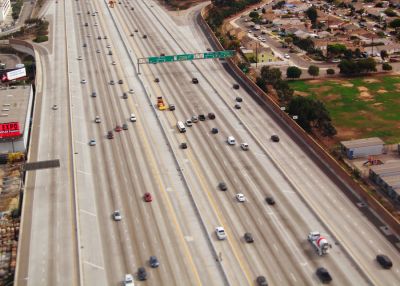
A freeway is a highway designed for high speed traffic, with fully controlled access over entrance to, and exit from, the highway.
Freeway is the highest functional class of road.
The following roads shall be classified as Freeway :
- All Interstate Highways.
- This includes all roads classified in FHWA's functional classification as Interstates.
- This includes three-digit Interstate spurs and loops (e.g., I-610; I-585).
- This includes the few grade-intersected, undivided, and/or narrow portions of the Interstate Highway System.
- This does not include Interstate Business Loops and Business Spurs (e.g., I-69 Business Loop), unless they meet the standards for Other Freeways and Expressways defined below.
- Roads classified in FHWA's functional classification as Other Freeways and Expressways which meet the following criteria:
- No at-grade crossings.
- No at-grade intersections.
- No direct property access.
- No stop lights (except sometimes on ramps).
- No stop signs.
- Connected to other roads exclusively by interchanges:
- Entrance via ramps only, typically with acceleration zones.
- Exit via ramps only, typically with deceleration zones.
- Note: Some states refer to this class as Other Freeways. In these states, every road in this class is a Freeway.
For information on how to best layout freeways and their junctions, please review the section on freeways in the Junction Style Guide. For specific guidelines in other countries refer to this page for more information.
Major Highway

Principal arterials are the primary routes for traveling throughout the country, from one city to another, over long distances. Many principal arterials are freeways or expressways, but many others are not.
As a nationwide system, the United States Numbered Highways, or U.S. Highways, system provides a direct links between regions not served by the Interstate Highway System, and as alternatives to Interstate travel in the case of heavy traffic or incident.
The following roads are to be classified, at minimum, as Major Highway :
- Roads classified in FHWA's functional classification as Principal Arterials or Other Principal Arterials.
- Roads classified in FHWA's functional classifications as Other Freeways and Expressways which do not meet the criteria for Freeway.
- This includes partially-limited-access roadways (or "expressways"). These are roads that have a lot of the characteristics of freeways, but also have occasional at-grade intersections with other roads.
- Note: Every partially-limited-access roadway is a Major Highway; this does not mean that every Major Highway must be partially-limited-access.
- Note: "Expressway" is used as a shorthand term for partially-limited-access roads. This does not mean every road named "Expressway" is a Major Highway.
- Note: Some states refer to this class as Other Freeways. In these states, every road in this class is a Freeway.
- Roads in the United States Numbered Highways system (US Highways).
- This includes Alternate (ALT), Bypass (BYP), Connector (CONN), Truck, and Scenic US Highways.
- This does not include Business (BUS), Spur, and Loop US Highways.
- Business routes (Spurs and Loops) in the Interstate Highway System (e.g., I-69 Business Loop).
Minor Highway
Minor arterials (or other arterials) are secondary routes for traveling between cities over moderately long distances. Minor or other arterials are classified in Waze as Minor Highways.
Each of the fifty states (along with the District of Columbia and some of the United States's overseas territories) has a numbered state highway system. Roads in these systems are designated and selected by their respective State Departments of Transportation as part of statewide networks of important travel links between cities and communities of those states. These roads, while of lesser national importance, are nevertheless essential for travel within the state.
The following roads are to be classified, at minimum, as Minor Highway :
- Roads classified in FHWA's functional classification as Minor Arterials or Other Arterials.
- Signed, numbered routes in state, D.C., and territorial highway systems.
- This includes Alternate (ALT), Bypass (BYP), Connector (CONN), Truck, and Scenic state highways.
- This includes Spur state highways when they are used to connect state highways with other state highways, US Highways, or Interstates; i.e., Spur highways which are used like Connector (CONN) highways.
- This does not include Business (BUS), Loop, and other Spur state highways.
- Business (BUS), Loop, and Spur US Highways.
Note: Not every state highway system is the same. Some state systems may be overinclusive, whether because of differing standards or because of political corruption and pork barrel spending; as such, your state may make exceptions where some lesser state highways are better represented by the Primary Street type. Contact your regional coordinator before making these decisions.
Ramps 
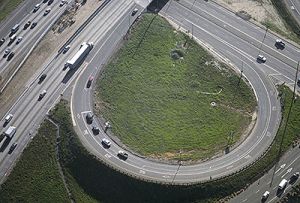
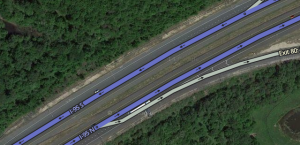
The following are to be classified as Ramp .
- Roads which connect roadways to other roadways as part of an interchange. This includes all freeway exits and entrances.
- Roads connecting freeways and highways with rest areas, parking areas, and service plazas (e.g., "Exit to Service Area").
- Jughandles.
- Median U-turn intersection ("Michigan left") segments.
- J-turn (RCUT/"Superstreet") segments.
The following are not to be classified as Ramp .
- At-grade connectors, unless they fit into one of the exceptions (see article).
- Turn lanes.
Ramp names do not appear on the client application map, but do appear in the text for routing directions. Entrance and exit ramps often contain a lot of text which is duplicative of roads already in the area, so this text is suppressed until the user actually needs it. This is also the reason for using the ramp type for named MUTI and jughandle segments—the text is needed for effective navigation instructions but would needlessly clutter the ramp.
Information on how to lay out ramps and set the proper angles from the main road can be found in the Junction Style Guide.
Streets


The Street types are for local and short-distance travel. Street types are used at the beginning and end of long routes as well.
Primary Street 
Collectors are roads used with medium-low traffic densities which are used to bring traffic from local streets to arterials and vice versa. Collectors are classified in Waze as Primary Streets.
Some states designate county routes which are important for travel within a county. These routes serve important functions in a short-distance capacity.
The following roads are to be classified, at minimum, as Primary Street :
- Roads classified in FHWA's functional classification as Major Collectors or Minor Collectors.
- Signed, numbered county routes (and, in Louisiana, parish routes).
- Business (BUS) and Loop state highways, and Spur state highways which are not used as connectors.
- Frontage roads which serve as the means of access between freeways/expressways and surface streets, if not otherwise classified.
- Some functional classification maps are not produced in high enough detail to determine the class of frontage roads. On maps that are produced in high detail, frontage roads are almost universally classified as Major Collectors or higher.
Note: Some states or counties may designate county routes differently than others. Check your state's page for possible exceptions to this rule.
Service Road 
Deprecated. Do not use this type.
As stated above, frontage roads should generally be set to at least "primary street" type, if not marked as a higher type on a functional class map.
Many frontage roads are used as "feeder roads" or "access roads", often the primary or only means of entering and exiting a freeway. Setting these to the "street" type, as has been done in the past, has the potential to invalidate good routes which use freeways and major/minor highways. To ensure that routing works, always use at least "primary street" for frontage roads that are used in this way. It may be desirable to set the entire frontage road to the same type to achieve a more contiguous map appearance.
Street 
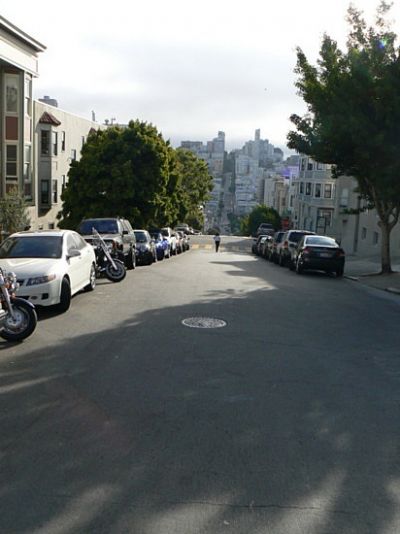
- Any road for public travel which does not meet the criteria for any other type shall be classified as a Street . Shown as "local roads" in some functional classification maps; not shown at all in others.
Quick reference chart
Refer to this chart to determine the road type of a given road easily.
| Highway Systems | |||||||||
|---|---|---|---|---|---|---|---|---|---|
| Interstate | Interstate Business Loop/Spur | US Hwy (incl. some special routes) | US Hwy BUS, SPUR, LOOP | State Hwy (incl. some special routes) | State Hwy BUS, SPUR[a], LOOP | County Route | Locally-maintained | ||
| F u n c t i o n a l C l a s s |
Interstate | Fw | n/a | n/a | n/a | n/a | n/a | n/a | n/a |
| Other Freeway | n/a | Fw | Fw | Fw | Fw | Fw | Fw | Fw | |
| Other Expressway | n/a | Major | Major | Major | Major | Major | Major | Major | |
| (Other) Principal Arterial | n/a | Major | Major | Major | Major | Major | Major | Major | |
| Other/Minor Arterial | n/a | Major | Major | Minor | Minor | Minor | Minor | Minor | |
| Major Collector | n/a | Major | Major | Minor | Minor | PS | PS | PS | |
| Minor Collector | n/a | Major | Major | Minor | Minor | PS | PS | PS | |
| Local/not mapped | n/a | Major | Major | Minor | Minor | PS | PS | Street | |
^a When a state highway "SPUR" route is used to connect a state highway with another state highway, a US highway, or an Interstate (i.e., when it is used as a connector/CONN route), use the first state highway column.
| Fw | Freeway |
| Major | Major Highway |
| Minor | Minor Highway |
| PS | Primary Street |
| Street | Street |
Other drivable roads
Dirt
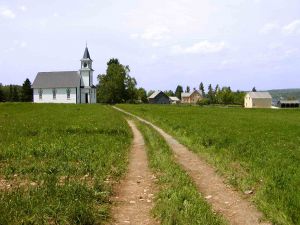
A road that is not paved.
Marking a road as "Dirt Road" will have the following consequences: - Road name will not display in client. - Routing will be restricted to avoid this road if user has disabled the use of dirt roads in client settings.
Parking Lot Road
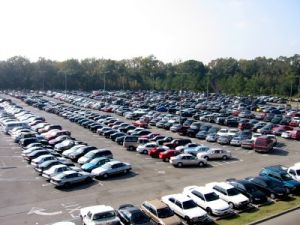
Parking lots, along with other publicly accessible roads such as alleys that should not be used for traffic routing unless directly at the start or end point of a route.
- Do not map the rows within parking lots because it clutters the map. See this additional page for more details on how to map parking lots.
- Parking Lot roads have a transition penalty when exiting the Parking Lot road segment. This should prevent Waze from routing you through a Parking Lot as a shortcut.
- Use Parking Lot road type for all necessary segments in the Parking Lot.
- The proper use of parking lot roads can also help to avoid automated traffic jam reports as well as Map Problems related to Wazers driving in unmapped parking lots. Draw in the drivable portions of the parking lot that are near streets and other roadways. This will prevent the Waze routing server from assuming you must be on the main road when in fact you are stopped in the parking lot.
Additional information on this topic can be reviewed in the forums.
Information on mapping a parking lot landmark "place" is covered here.
Private Road
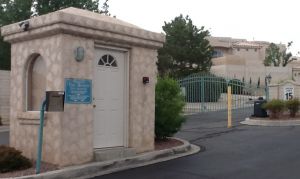
Private roads are useful for the following situations:
- Gated communities with controlled access
- Schools and Universities
- Military Bases
- Roads within apartment complexes and trailer parks
- Businesses with controlled access (gates / guard)
However, using private roads in some of these situations may require more complex mapping as covered in the article Private Installations. Be sure to read through that article before setting a whole neighborhood to all private roads.
Private roads function in a similar way to Parking Lot roads using a transition penalty when leaving the Private Road. This transition penalty keeps Waze from incorrectly routing Wazers through a private area as a shortcut.
Private roads do not suppress automated traffic jams in the Waze application.
Non-drivable roads
Your car should not be here!
- These may be useful for points of reference when navigating such as seeing on a map where a turn is in relation to a railroad crossing.
- When Waze users travel on a non-vehicle route such as a bicyclist or mass-transit rider, marking these routes can be useful to explain the GPS traces that result.
- If a base map scan has non-drivable routes on it, it is important to mark these to prevent traffic routing onto them.
- Non-drivable routes should not have any type of junction with a drivable road. Because of the way the routing engine uses a penalty system, Waze will route users to drive on these "Non-drivable" road types if they are connected to drivable roads. When crossing a drivable road, the non-drivable road should be bridged across without a junction between them and set at a different Elevation.
Emergency Vehicle and DOT Service Roads 
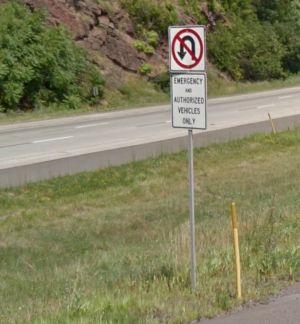
"Emergency and Authorized Vehicles Only" and DOT Service Roads are to be treated as Non-drivable roads. These are found primarily through the median of divided highways to connect opposite direction lanes. If mapped, they should not be connected to any drivable road with properties set to road type Private Road, elevation -5, and lock at the highest rank of the editor up to 5.
Walking Trails 
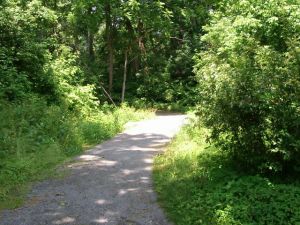
Also bike trails
Pedestrian Boardwalks 

Stairway 
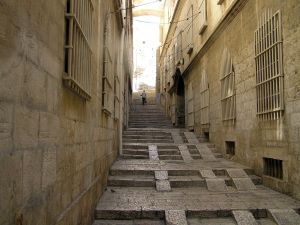
Railroad 
Train and Light Rail tracks currently do not appear in Waze client, but may in a future release. For that reason some editors may map at least the portion of the railroad that cross drivable roads. However, DO NOT create a junction between the drivable road and the railroad. The Waze routing engine will properly calculate the average time through a segment regardless if the railroad creates a junction on that segment or not. By not creating a junction, there is less chance for turn restrictions to be set incorrectly and potentially cause automated errors in the system.
Currently all Railroad segments should be set to Elevation -5. This helps ensure the routing engine does not try to connect or route drivers from roads onto non-roads by mistake. It acts to prevent false system reporting that the roads should be connected.
Waze - Support
Railroads should be labeled as such in the editor. For the time being they won't make it to the client indeed, but in the future we might want to use them for display purposes.
The "railroad" road type in the editor is under "non drivable" so it should not cause any issue to the routing.
For specific recommendations in other countries outside the United States, please see the entry for the country in question here.
Runway/Taxiway
For aircraft at airports. Where a street also serves as a taxiway (such as in a community with through-the-fence access) map the street as a street. No drivable road should connect to or cross over any runway. A road may cross under a runway.
Each runway may be mapped as a single segment for identification purposes and locked to prevent lower ranking editors from attaching a road to the runway. Do not form junctions where runways cross. Name each runway using the FAA airport identifier, the word runway, and the runway designations with the lower number first (e.g., "KSMF Runway 16R-34L".)
Roundabouts 

Roundabouts have few principals:
The first one, each node on the roundabout can only be connected to no more than one segment.
Each connection has a spectrum that exists in order to notify the Client on how to define the message (Go straight, exit through the 2nd / 3rd / 4th exit).
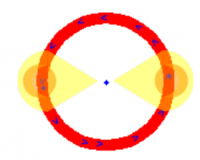
The system will include the radius border from the center and notify the user accordingly.
For more information on when to create a Roundabout or a loop instead, please review the Junction Style Guide.
For information on what type of road to set a Roundabout to, please review Creating and Editing a Roundabout
Special case roads not covered
There are a number of other types of roadways and lane types which are not directly covered with the current options above. In some cases there are plans to add some of these special cases, but in the mean time the following guidelines are the best that can be done with the current settings.
Bus or cab only lanes
When a road or lane is designated for bus or cab use only, mark that road segment(s) as a Private Road to prevent the Waze router from using that segment(s) for general traffic, since the majority of the users will not be able to use that lane. It is also advisable to set the turn restrictions to prevent turns into that segment(s), but permit turns exiting the segment.
If a road is one-way, but allows bus or cab traffic to flow the other direction, leave the road as one-way with the normal flow of traffic. There is no need to create a second road traveling the opposite direction for the bus and cab-only traffic.
Driveways
Most urban communities have very short driveways between the named road they live on and the garage or carport on their property. In general these very short segments should not be mapped because they have no name, would clutter the map in the client app, take a lot of time to draw, and would greatly increase the overall size of the Waze mapping database with very little return.
In the case of very long driveways, it may helpful to a driver to see the driveway mapped on the client app or even necessary for Waze to determine how to reach the destination. In those cases it may be prudent to add a road. See the article on Driveways for more information.